This annual report outlines results for the HIV Leadership Through Accountability programme for the period of April 2012 to March 2013.
GTF361 – Fifth LTA Annual Report- 1 April 2012 to 31 March 2013
This annual report outlines results for the HIV Leadership Through Accountability programme for the period of April 2012 to March 2013.
GTF361 – Fifth LTA Annual Report- 1 April 2012 to 31 March 2013
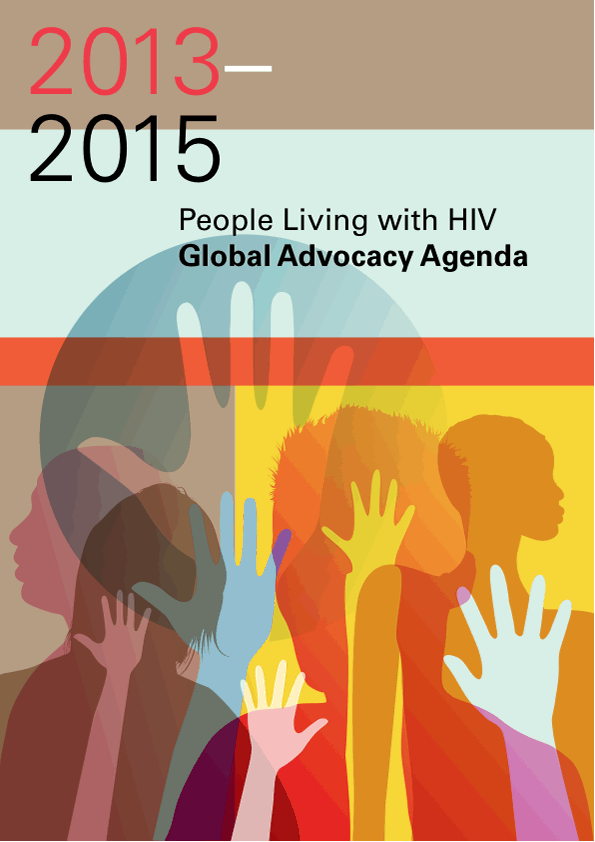
The People Living with HIV Global Advocacy Agenda, 2013-2015, was launched in December 2012. The Global Advocacy Agenda has guided networks of people living with HIV and other organizations in their advocacy since 1999.Throughout 2012, people living with HIV across the globe took part in an extensive consultation process, informing the development of this renewed Global Advocacy Agenda.
The Global Advocacy Agenda is a groundbreaking document for the movement of people living with HIV, guiding efforts to achieving Positive Health, Dignity and Prevention. Capturing the unmet needs of people living with HIV with respect to Prevention, Treatment, Care and Support; Human Rights; and Community Mobilisation, Strengthening and Activism, the Global Advocacy Agenda is designed to strengthen and enhance existing advocacy initiatives, in this critical period leading up to 2015. It reflects the diversity of the advocacy efforts within the community and as such is more than just an advocacy resource but a tool which galvanizes and unites people living with HIV and allies.
Despite the varied needs of people living with HIV the Global Advocacy Agenda focuses on the commonalities and principles that are pre-requisites to realizing a truly effective HIV response. However, as the rights and involvement of people living with HIV are still too often ignored for political, ideological and economic reasons, people living with HIV must take a lead in shaping the advocacy that effects change in all our lives – our meaningful involvement is crucial.
Available in English, French, Spanish, Russian and Chinese.
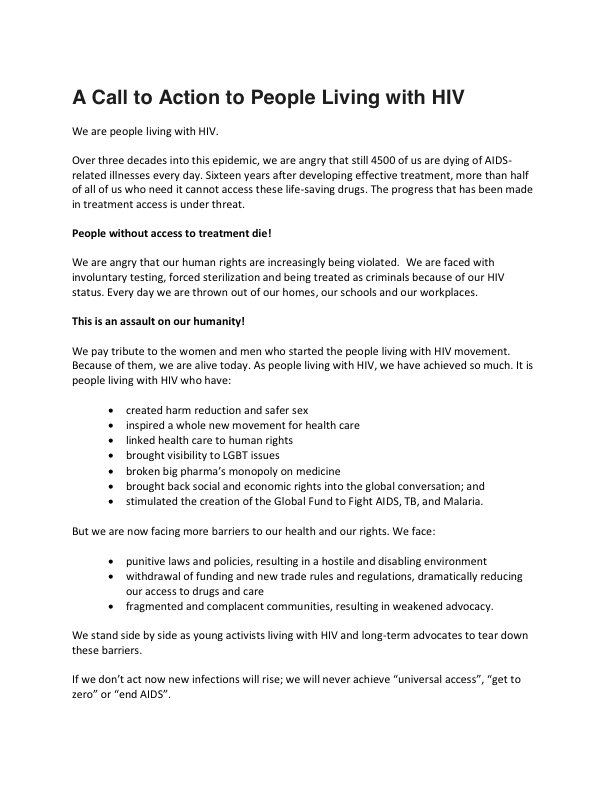
We are people living with HIV.
Over three decades into this epidemic, we are angry that still 4500 of us are dying of AIDS- related illnesses every day. Sixteen years after developing effective treatment, more than half of all of us who need it cannot access these life-saving drugs. The progress that has been made in treatment access is under threat.
People without access to treatment die!
We are angry that our human rights are increasingly being violated. We are faced with involuntary testing, forced sterilization and being treated as criminals because of our HIV status. Every day we are thrown out of our homes, our schools and our workplaces.
This is an assault on our humanity!
We pay tribute to the women and men who started the people living with HIV movement. Because of them, we are alive today. As people living with HIV, we have achieved so much. It is people living with HIV who have:
But we are now facing more barriers to our health and our rights. We face:
We are in a state of emergency!
We will have access to the best available prevention, treatment and care for ourselves and our children.
We will enjoy all human rights and freedoms.
We will not stand idle and watch our sisters and brothers die.
We, as a coalition of people living with HIV, unite around the People Living with HIV Global Advocacy Agenda, which was developed by our communities around the world. The Global Advocacy Agenda describes what we all still need to ensure access to prevention, treatment, care and support, to protect our human rights and strengthen all of our communities.
This is a call to reinvigorate and galvanize the movement of people living with HIV in the face of this unprecedented global crisis that affects us all.
We urge all people living with HIV, networks of people living with HIV, and networks of key populations, to commit to join together in solidarity.
The next struggle of the People Living with HIV Movement has begun. For success, we need an even greater and more forceful movement that spans every region and every country with its roots embedded deep in each of our communities.
Please join us!
Available in the Arab, Chinese, Dutch, English, French, Russian and Spanish
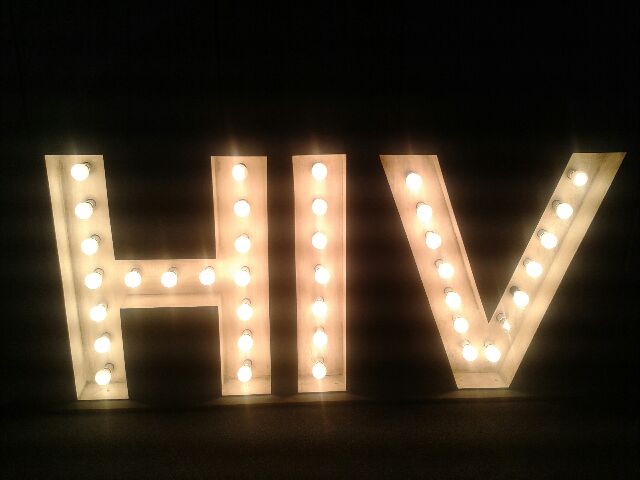
A summary report of the HIV Leadership through Accountability final project meeting held in Dakar, Senegal 3-5 June, 2013.

The side event “Post-2015 Development Framework…what’s in it for young people?” was held following the General Assembly 68th Session’s High Level Event on the MDGs and brought together representatives of UN Member States, UN agencies and civil society, as well as key politicians and young people living with and affected by HIV. The aim was to facilitate an open and frank discussion with young people living with and affected by HIV and representatives of key population groups giving them a voice in the global post-2015 debate and to better understand the challenges they face in accessing comprehensive HIV and sexual and reproductive health services and their needs and hopes for the future.
The event was co-organized by the African Services Committee, the Global Youth Coalition on HIV/AIDS (GYCA), the HIV Young Leaders Fund , Housing Works, ICASO, International AIDS Vaccine Initiative (IAVI), International Civil Society Support (ICSS), the International HIV/AIDS Alliance, the International Women’s Health Coalition and STOP AIDS NOW!.





Prosecutions of people living with HIV who have, or are believed to have, put others at risk of acquiring HIV continue to occur in many countries around the world under outdated or overly broad HIV-specific criminal statutes or the inappropriate application of a wide range of general criminal laws.
These laws and prosecutions are often perceived to be about deterring or punishing malicious, intentional HIV transmission when, in fact, the vast majority of cases have involved neither malicious intent nor transmission.
Such laws and prosecutions for alleged HIV non-disclosure, potential or perceived exposure and non-intentional transmission (‘HIV criminalisation’) are of concern in the following ways:
Prosecuting consensual sex between adults even when there was prior disclosure of HIV-positive z status;5 or, in the absence of disclosure, the alleged exposure posed a very low risk of HIV infection,6 and/or HIV transmission did not occur.
Effectively treating sex between a person living with HIV and an HIV-negative partner as a physical or sexual assault in the absence of disclosure of known HIV-positive status, regardless of whether there was any malicious intent to harm.
Applying harsh prison sentences to alleged HIV “exposure” during non-consensual acts that pose very little or no risk of HIV infection, e.g. biting, spitting or scratching.9 Applying increased prison sentences to people living with HIV who are convicted of sex work, even when there is no evidence that they have intentionally or actually put their clients at risk of acquiring HIV.
Applying the criminal law to vertical transmission of HIV during pregnancy or via breastfeeding.
In July 2012, the Global Network of People Living with HIV (GNP+) and the HIV Justice Network presented an analysis of trends in global HIV criminalisation at the 19th International AIDS Conference in Washington DC.
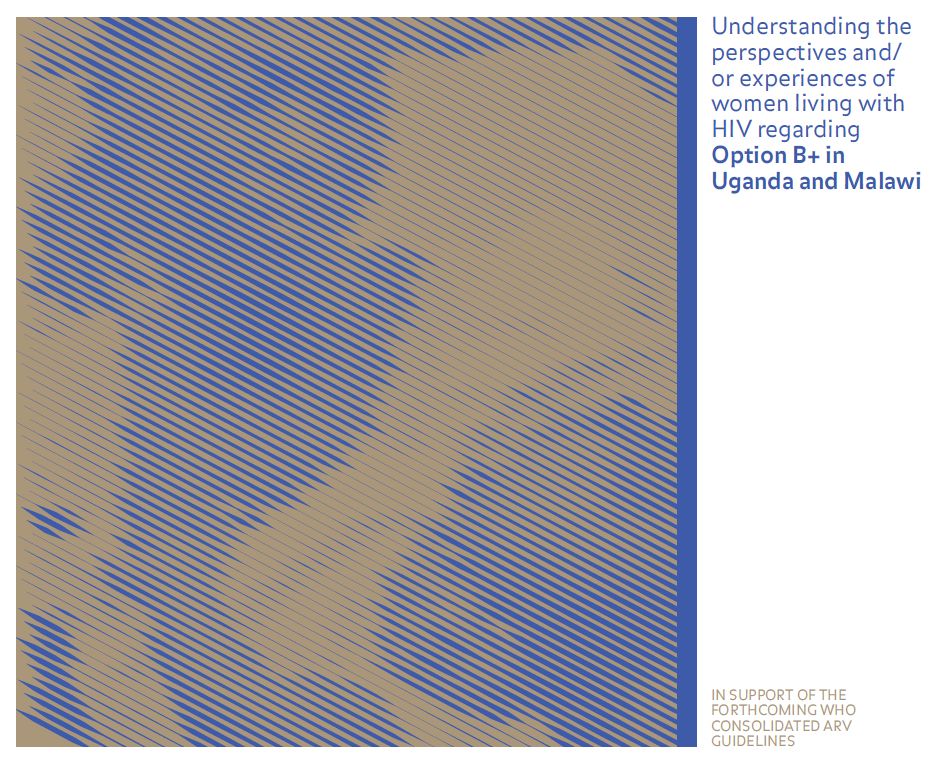
Option B+ is a prevention of vertical transmission approach for expectant mothers living with HIV in which women are immediately offered treatment for life regardless of their CD4 count. This approach offers advantages such as protection of partner(s) and (unborn) child, as well as benefits to the woman’s health, but also carries with it risks.
In the report GNP+ and ICW present the results of 8 different focus group discussions that discussed these issues in Uganda and Malawi. Below poster summarises the results.
For additional information on Uganda and Malawi, visit the stigma index website

In the 2013 Consolidated Guidelines on the Use of Antiretroviral Drugs for Treating and Preventing HIV Infection (2013 Guidelines), the World Health Organization (WHO) takes a
welcomed step in recommending that people living with HIV everywhere be offered a standard of antiretroviral treatment and care that is closer to what is available in resource-rich countries.
Together with STOP AIDS NOW and the HIV Alliance, we have summarised the guidelines and noted recommendations and key issues from a community and civil society perspective.

To inform the 2013 revision of the WHO Guidelines on HIV treatment GNP+ and the HIV Alliance conducted community consultations.
Expanding antiretroviral therapy (ART) access is a cornerstone of reducing mortality and improving health outcomes among people living with HIV (PLHIV) in all settings. Given recent advances in scientific evidence on the use of antiretroviral drugs (ARVs) for HIV treatment, including their impact on health outcomes and HIV prevention, the World Health Organization (WHO) has reviewed and consolidated all ARV-related guidelines into a single compendium for publication in 2013.
The 2013 WHO Consolidated ARV Guidelines on the Use of Antiretroviral Drugs for Treating and Preventing HIV Infection (2013 ARV Guidelines) focus on four areas:
(1) clinical guidelines for adults and adolescents;
(2) clinical guidelines for maternal and child health;
(3) operations and service delivery guidance (for the first time); and
(4) guidance for programme managers.
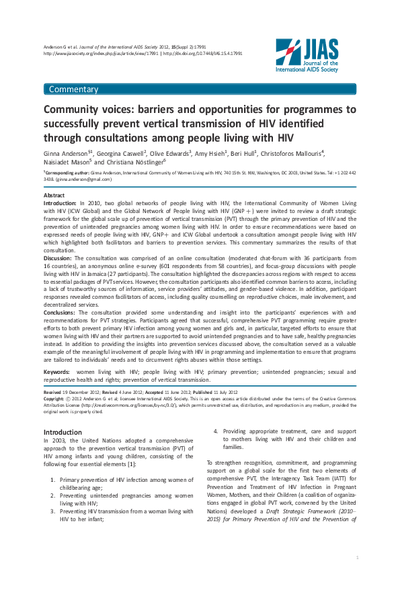
Introduction: In 2010, two global networks of people living with HIV, the International Community of Women Living with HIV (ICW Global) and the Global Network of People living with HIV (GNP+) were invited to review a draft strategic framework for the global scale up of prevention of vertical transmission (PVT) through the primary prevention of HIV and the prevention of unintended pregnancies among women living with HIV. In order to ensure recommendations were based on expressed needs of people living with HIV, GNP+ and ICW Global undertook a consultation amongst people living with HIV which highlighted both facilitators and barriers to prevention services. This commentary summarizes the results of that consultation.
Discussion: The consultation was comprised of an online consultation (moderated chat-forum with 36 participants from 16 countries), an anonymous online e-survey (601 respondents from 58 countries), and focus-group discussions with people living with HIV in Jamaica (27 participants). The consultation highlighted the discrepancies across regions with respect to access to essential packages of PVT services. However, the consultation participants also identified common barriers to access, including a lack of trustworthy sources of information, service providers’ attitudes, and gender-based violence. In addition, participant responses revealed common facilitators of access, including quality counselling on reproductive choices, male involvement, and decentralized services.
Conclusions: The consultation provided some understanding and insight into the participants’ experiences with and recommendations for PVT strategies. Participants agreed that successful, comprehensive PVT programming require greater efforts to both prevent primary HIV infection among young women and girls and, in particular, targeted efforts to ensure that women living with HIV and their partners are supported to avoid unintended pregnancies and to have safe, healthy pregnancies instead. In addition to providing the insights into prevention services discussed above, the consultation served as a valuable example of the meaningful involvement of people living with HIV in programming and implementation to ensure that programs are tailored to individuals’ needs and to circumvent rights abuses within those settings.
Keywords: women living with HIV; people living with HIV; primary prevention; unintended pregnancies; sexual and reproductive health and rights; prevention of vertical transmission
(Published: 11 July 2012)
Citation: Anderson G et al. Journal of the International AIDS Society 2012, 15(Suppl 2):17991
http://www.jiasociety.org/index.php/jias/article/view/17991 | http://dx.doi.org/10.7448/IAS.15.4.17991

There is growing interest in the evidence that antiretroviral therapy (ART) can be used not only as treatment for people living with HIV, but to prevent or reduce transmission of HIV.
This paper focuses on the prevention of sexual transmission from persons living with HIV through the use of ART. The paper focuses on what this means for people living with HIV (at an individual level) and what it means for public health (at the population level).
Informed by a consultation with GNP+’s Board and Secretariat, it articulates conditions needed for treatment as prevention to work effectively while protecting the rights of people living with HIV.

GNP+ is proud of its achievements and progress over the last few years. To ensure maximum transparency and accountability, GNP+ publishes its Annual Reports after they have been audited and approved by an external auditor.
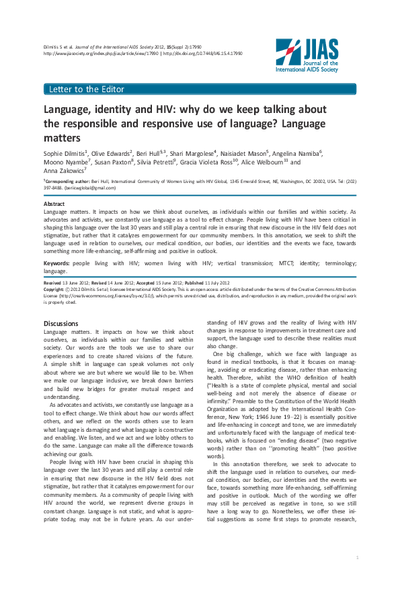
Why do we keep talking about the responsible and responsive use of language? Language matters
Language matters. It impacts on how we think about ourselves, as individuals within our families and within society. As advocates and activists, we constantly use language as a tool to effect change. People living with HIV have been critical in shaping this language over the last 30 years and still play a central role in ensuring that new discourse in the HIV field does not stigmatize, but rather that it catalyzes empowerment for our community members. In this annotation, we seek to shift the language used in relation to ourselves, our medical condition, our bodies, our identities and the events we face, towards something more life-enhancing, self-affirming and positive in outlook.
Keywords: people living with HIV; women living with HIV; vertical transmission; MTCT; identity; terminology; language
(Published: 11 July 2012)
Citation: Dilmitis S et al. Journal of the International AIDS Society 2012, 15 (Suppl 2):17990
http://www.jiasociety.org/index.php/jias/article/view/17990 | http://dx.doi.org/10.7448/IAS.15.4.17990
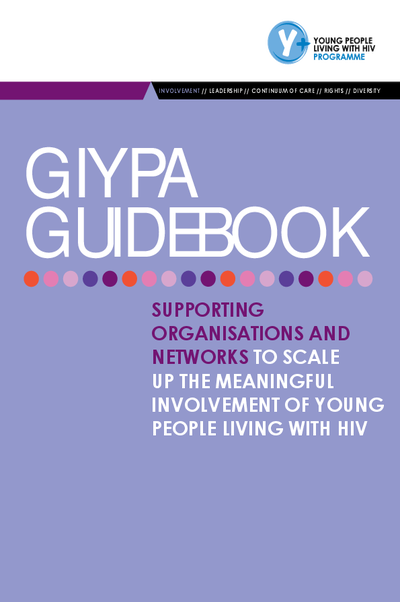
GNP+ has recently finalised and published two documents which aim to enhance the greater and more meaningful involvement of young people living with HIV within the HIV response. Supported by funding from the HIV Young Leaders Fund ( www.hivyoungleadersfund.org), GNP+ conducted research among 350 young people living with HIV, and among over 175 youth led organisations and networks living with HIV, to identify the key barriers faced by YPLHIV to engaging more meaningfully in the HIV response. The findings from this research led to the development of these two tools:

GNP+ developed two documents which aim to enhance the greater and more meaningful involvement of young people living with HIV within the HIV response. Supported by funding from the HIV Young Leaders Fund ( www.hivyoungleadersfund.org), GNP+ conducted research among 350 young people living with HIV, and among over 175 youth led organisations and networks living with HIV, to identify the key barriers faced by YPLHIV to engaging more meaningfully in the HIV response. The findings from this research led to the development of these two tools:

There is growing interest in the evidence that antiretroviral therapy (ART) can be used not only as treatment for people living with HIV, but to prevent or reduce transmission of HIV.
This paper focuses on the prevention of sexual transmission from persons living with HIV through the use of ART. The paper focuses on what this means for people living with HIV (at an individual level) and what it means for public health (at the population level).
Informed by a consultation with GNP+’s Board and Secretariat, it articulates conditions needed for treatment as prevention to work effectively while protecting the rights of people living with HIV.